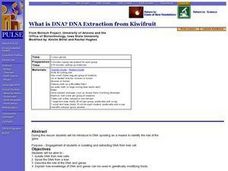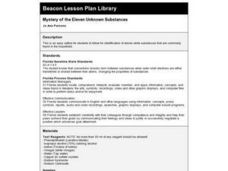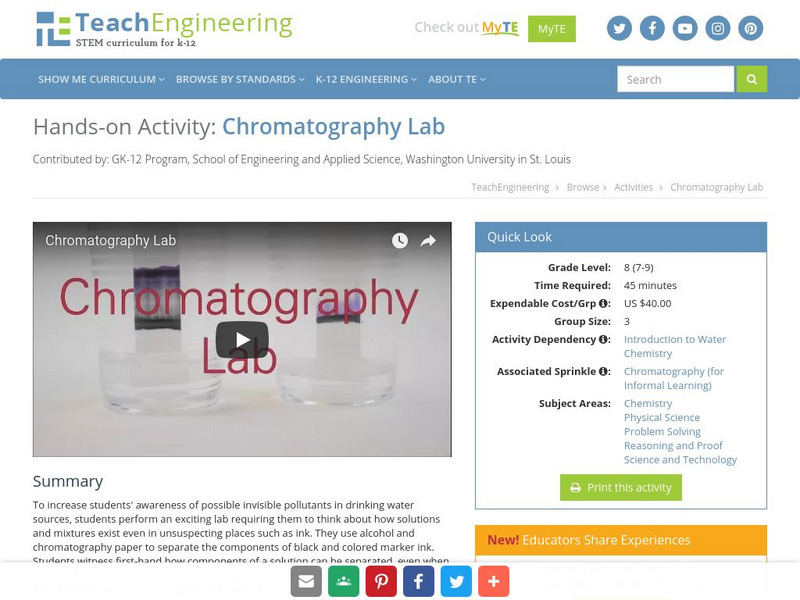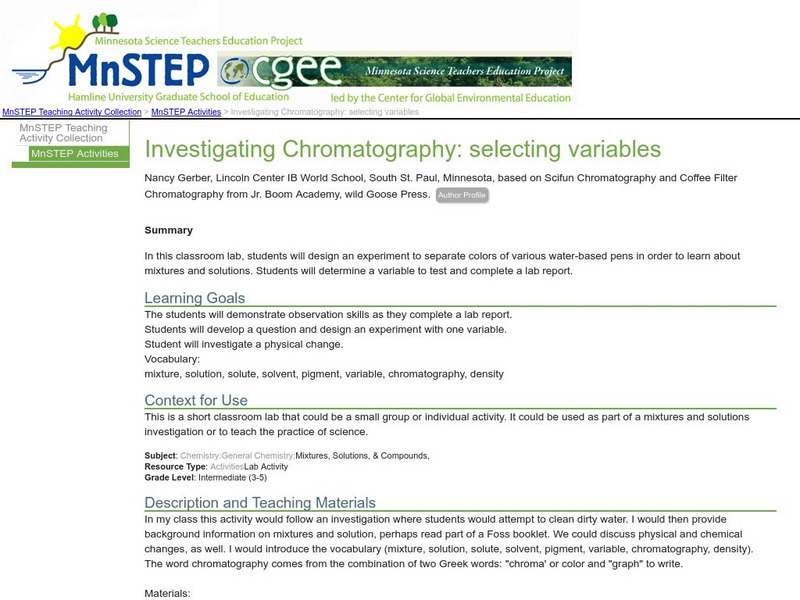Curated OER
Acid Rain Simulation
Students collect data on causes of Acid Rain. In this science lesson, students simulate the effects that produce acid rain, collect and analyze data from their samples. They relate science and statistics in this lesson.
Curated OER
Rainbow Electrophoresis
Students are introduced to the principles of gel electrophoresis and also provides an opportunity for students to practice loading gels and prpetting. In this laboratory activity, food color is used to separate into constituent pigments.
Curated OER
What is DNA? DNA Extraction from Kiwifruit
Students isolate DNA from kiwi cells, spool DNA from a kiwi, describe role of the DNA and genes, and explain how knowledge of DNA and genes can be used in genetically modifying foods.
Curated OER
Chlorophyll
Middle schoolers use thin layer chromatography, TLC, to separate various pigments found in plants.
Curated OER
DNA Extraction From Living Things
Students extract DNA from split peas. In this biology lesson, students hypothesize what DNA looks like and perform the experiment to verify their hypothesis. They explain the importance of DNA in living things.
Curated OER
What Does That DNA Molecule Really Look Like???
Students extract DNA from animal liver cells. They separate, collect and describe the appearance from the extracted DNA while role playing as an intern in a city's forensics.
Curated OER
Striking it Rich with Chemistry
Young scholars identify the composition of different pennies. In this chemistry lesson plan, students use a post 1982 penny to observe chemical change. They explain how to turn a penny from copper to gold.
Curated OER
Our Food and Microorganisms
Students answer questions about how microorganisms can affect our food supply and how they can be controlled. The first set of inquiry activities are directed by the teacher. Subsequent activities are based on students generating their...
Curated OER
Mystery of the Eleven Unknown Substances
Fourth graders identify eleven white substances that are commonly found in the household. They, in pairs, perform experiments on a variety of substances, and must identify them based on the reactions they observe.
TeachEngineering
Teach Engineering: Chromatography Lab
To increase students' awareness of possible invisible pollutants in drinking water sources, students perform an exciting lab requiring them to think about how solutions and mixtures exist even in unsuspecting places such as ink. They use...
Science Education Resource Center at Carleton College
Serc: Investigating Chromatography: Selecting Variables
For this lab, students will demonstrate observation skills as they design an experiment to separate colors of various water-based pens in order to learn about mixtures and solutions. Students will determine a variable to test and...
Science Education Resource Center at Carleton College
Serc: Do Water Molecules Have Space Between Them?
In this chemistry lab, students investigate whether water molecules have any space between them by filling a glass with water, and adding salt without the water overflowing. They will also experiment with the temperature of the water.
Science Education Resource Center at Carleton College
Serc: Does Salt & Vinegar Have an Effect on Pennies?
During this lab students will experiment to see whether a salt and vinegar solution can clean a tarnished penny. Included on site is lesson plan and student worksheet.
Other
English Montreal School: Chemical vs. Physical Changes: Elements vs. Compounds
A laboratory experiment where students classify matter into a homogenous mixture, heterogeneous mixture, solution, or pure substance. Also students will test for physical and chemical changes.
Science Education Resource Center at Carleton College
Serc: Mn Step: Spotting Chromatography
A lab activity that introduces chromatography using markers, plus water and acetone as the solvents. Learners will take measurements to compare the mobile and stationary phases of the inks, and find the polarity of the inks and solvents....
















